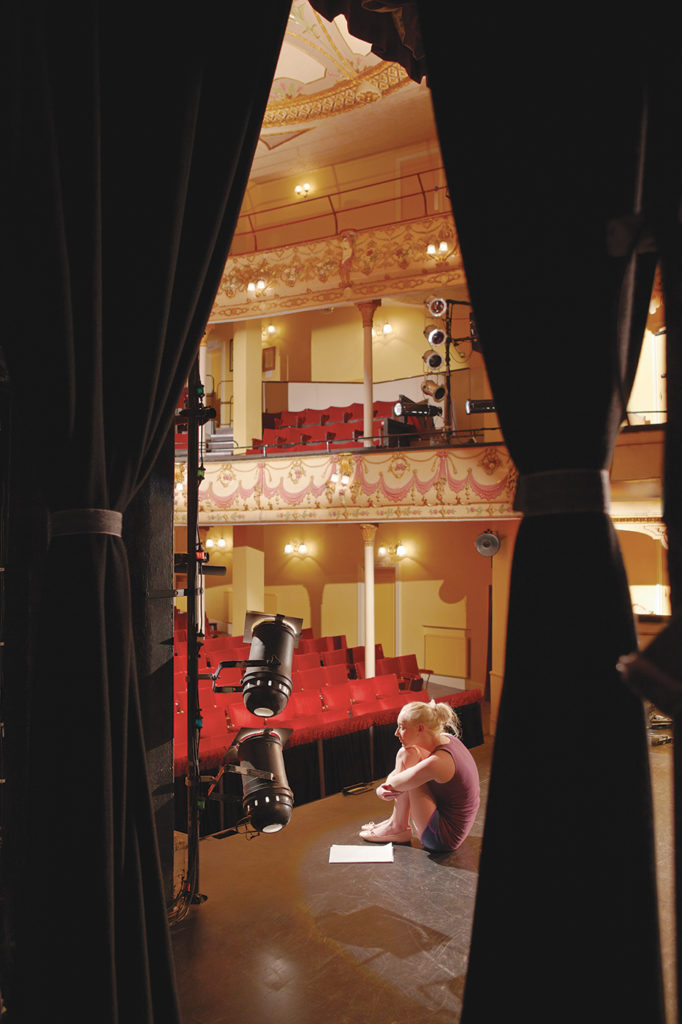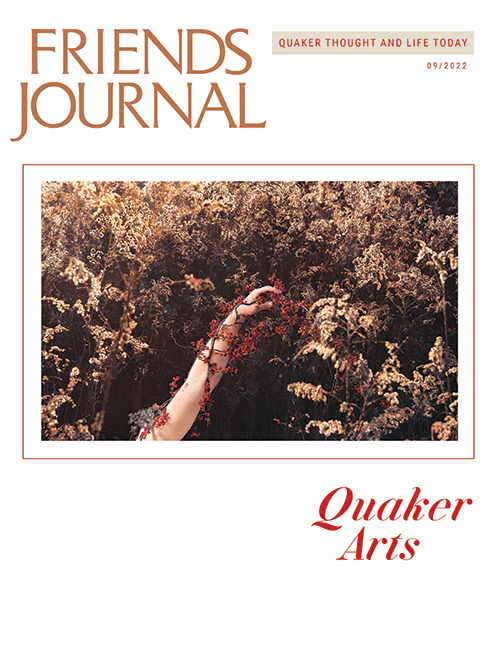An Introduction to the Quiet Way
In my first years as a Quaker, my theater life stood in uncomfortable tension side-by-side with my faith. Simplicity and honesty, my beliefs told me. Bold colors and brassy vocals, sang my stage training. Where lay the common ground?
Reading other Quaker actors’ words helped. Judi Dench and F. Murray Abraham, for example, helped me find confidence that the ethics of my spiritual forebears would ground me in my quest for honesty and truth on the stage. Still, something seemed right on the edge of discovery at the crossroads of Margaret Fell’s belief and Thespis’s profession. To land that discovery, I turned back to the exploration of theater I had begun a few years before.
While I was an undergraduate at the University of California, Berkeley, I had begun to formalize my understanding of visual art. Because I was raised by a musician and not a painter, what I had known about the visual arts was a matter of appreciation from the outside rather than an understanding of technique from the inside. My art history coursework opened my mind to key elements of traditional Western training that sparked first curiosity, then jealousy. In visual art, there were still lifes, character studies, and sketch works: all of these exercises were precise and rigorous ways of sharpening the craft of a two-dimensional artist. Is light and shadow lacking? Try a still life to refine your eye. Are your proportions or your musculature inaccurate? Life studies of a model can make all the difference.
And so it went: for every deficit in the painter’s skill, there was a targeted technique designed to fill it. But where are, I wondered, similar remedies for a stage performer? As a singer, I had exercises. As a dancer, I had sequences, like adagios. In traditional Asian theater, I was beginning to understand that I had forms to follow: specific gestures and techniques to learn in order to sharpen my skills. But somehow, modern American stage actors were handed only a vague series of emotional discovery exercises and taught to find their way through a script. Here, though, was where I had found the need to experiment.
It was a frustrating reality to bump up against. It made my chosen art form seem somehow unprofessional, even lazy. If the craft of an actor really was a craft, and not merely a pastime for bored extroverts, where was the rigor? Where was the real discipline? Other arts had specific remedies that drew their disciples closer to their deepest centers. What could actors do to be that true, that faithful?

Photo by moodboard
This led to the question, what if theater could be more like painting? I decided to simply start experimenting to find out. A small showcase of that same name, “Theater as painting,” begun with my friend Ben Chesluk, proved that when stripped of words, actors would simply interact improvisationally in a way that resonated emotionally and truthfully. I took away words and replaced them with music. (Ben had a deep file of excellent and obscure music at his command, as he was working at the student-run radio station KALX.) There was no story. We weren’t particular characters. We were merely two performers, solving problems we’d posed for ourselves on stage, in real time. We had rehearsal cubes and chairs to work with. They weren’t meant to represent a place, and we weren’t supposed to be living in a particular time. The acting wasn’t spoken, but it also wasn’t mime. It wasn’t scripted, but neither was it without shape. I’d begun to find what form an actor’s still life might take.
Cut back to me in a meeting for worship.
How different is it to find one’s truth in Quaker worship from finding the honesty of a moment between characters in a scene? Almost none at all, I found. It was time to meld my faith with my practice: my practice beneath the lights of the stage. Working with the teenaged apprentices I taught in my company, I began to create a wordless sandbox of interaction, a place in space and time where actors could have a simple set of guidelines for meeting each other. It was a spare place: a Quakerly, simple place. After having joined the Religious Society of Friends, I realized that in my original attempt to find a painter’s answer to being an actor, I’d taken the same sort of steps early Quakers had taken to find the Gospel Truth: they’d removed the impediments to seeing It clearly.
What removals did I seem to require?
I removed characters, reasoning that the actors would find them if they became necessary and when they became clear. I removed story, since dance had eliminated the need for story lines long before that. For that matter, a story turns out to be a naturally occurring phenomenon in the mind of an audience member, whether an actor or director intends it or not. I found that, Rorschach-like, the audience imposes a story if they find none handed to them. I removed words since, as Quakers have known for centuries, it is not the words but their source that matters. I replaced all of these voids with a few, simple instructions delivered to the actors before the exercise began, such as:
- You may not speak.
- You may use only a simple, repeatable, abstract gesture to communicate.
- You may enter the stage no more than two times.
- You may exit the stage no more than two times.
I then began to let the actors loose. Reducing the actors’ requirements to simple, mechanical moments gave them just enough shape to hold onto. The rest was up to them.
The impact was extraordinary. Most actors, especially new ones, have to work very hard to find a genuine and sincere presence on stage. The “look at me” impulse is so deeply rooted in performers that it takes a great deal of work by teachers and coaches to break through that presentational pose and find the emotionally open and genuinely magical ability to express and convey real feelings to a real group of real people sitting only a few feet away.
But in that light, isn’t what George Fox was calling out 375 years ago the shallow and performative mouthing of Christianity by mere “professors” of the faith? By returning to “primitive Christianity” and putting ministry in the hands of each and every worshiper, wasn’t the early Society of Friends seeking a greater Truth by reducing the barriers to finding it?
Just as with Friends in worship, the actors sometimes felt the weight of silence and developed a deep and fearful need to fill it with action. But, as with Friends, the actors soon learned to trust the silence, to love it, and to treat it as their ally in their search for genuine interaction with each other.
Like painters who sketch not for the gallery but for future, longer works, the actors soon come to engage in these exercises for their own sake; they were stripped of the need to find actions to arouse applause. Other, more nuanced instructions emerged. Costume and prop elements gingerly worked their way into the exercises. I’d found my long-sought still lifes. I began to call it the Quiet Way.
After many dozens of both young and more experienced actors began working with me in this new technique, I changed jobs and moved from solely studio work to running a high school theater program. I realized I would need to expand my techniques to create a path into the Quiet Way that a complete neophyte could follow. I added a long series of simple, concrete steps that helped formalize the individual choices actors make on stage. Again, reaching into my Quaker ethos, I saw that our diversity as a society had long held the same idea that I was trying to instill in my young artists: namely, what we do is what matters; how we get there is for the individual to discern, discover, and display. All an actor needs is to learn some of the simple mechanics of how a stage works, and the rest can sort itself out with practice. Which direction is upstage right? What does it mean to stand quarter-open? These sort of technical details were like learning the difference between watercolors and acrylics. They weren’t the art itself, but the art was made more difficult if one didn’t know the difference. So, with as few words as possible and with as little character or story prescribed, I created simple ways to learn enough to step into the sandbox I’d created. And it worked.
Years and hundreds of students later, the Quiet Way now has a complete and coherent course for actors of all levels of experience to traverse. Like in Quaker meeting, it is often the young who have less to unlearn and so take to it most easily. Like Quaker worship, it can take time for its effect to sink in. But, like true worship, this Quakerly approach to my seemingly very un-Quakerly art form digs deep: sorting out truth from falsehood in the heart of the individual, and reveals not the outward form but the Inner Spirit. It is, I suspect, my most Quakerly activity in my life so far, and I’m deeply grateful for the experience.




“For that matter, a story turns out to be a naturally occurring phenomenon in the mind of an audience member, whether an actor or director intends it or not.”
How true and even obvious, yet there is little room in most theater to make space for this tendency. 🤔